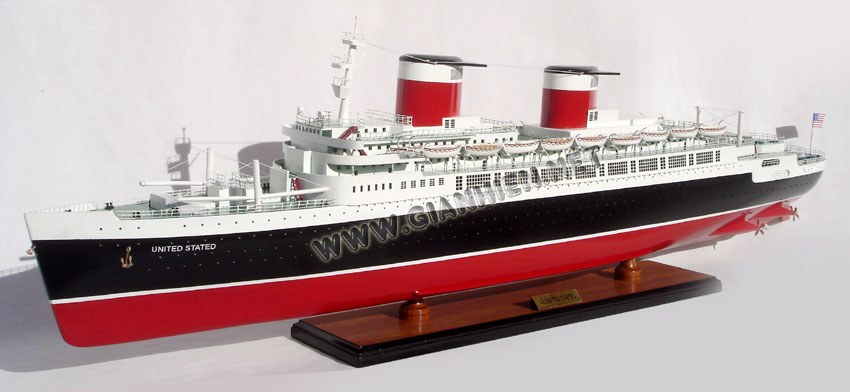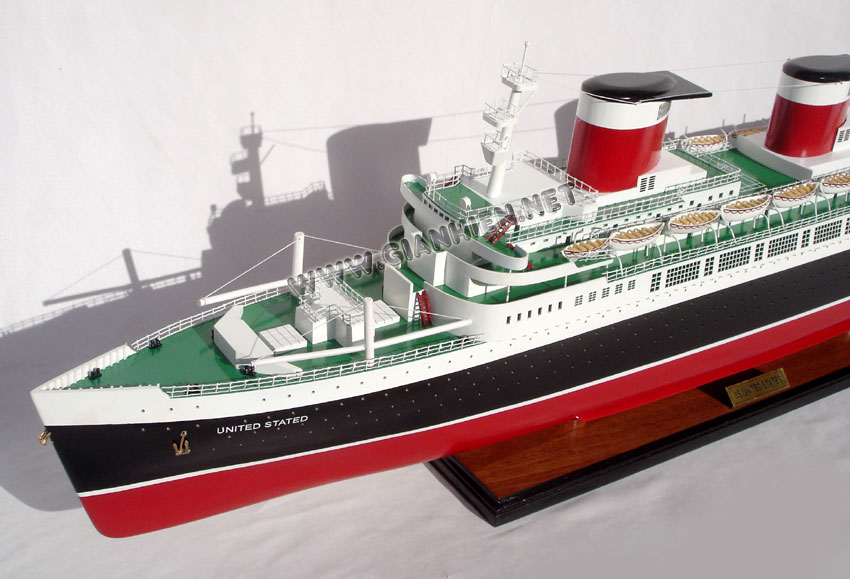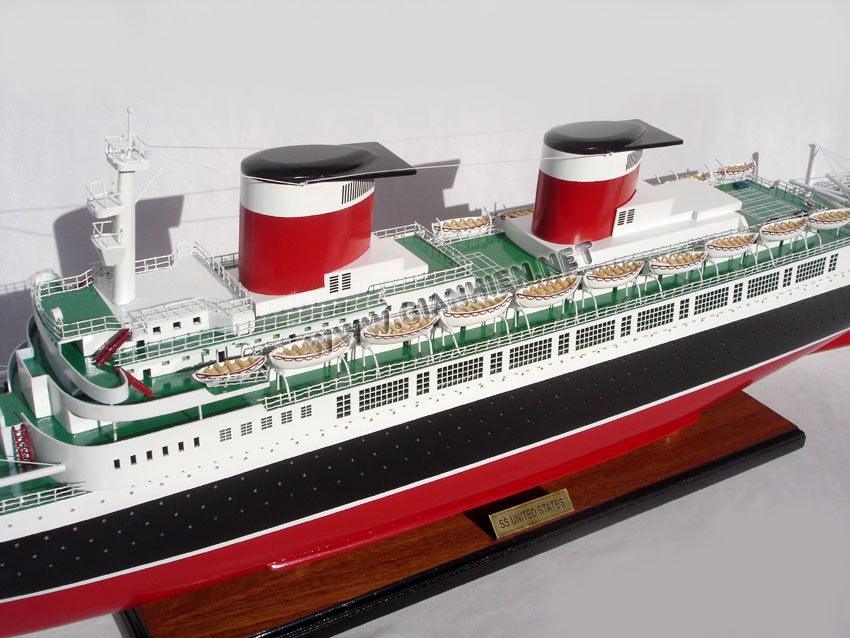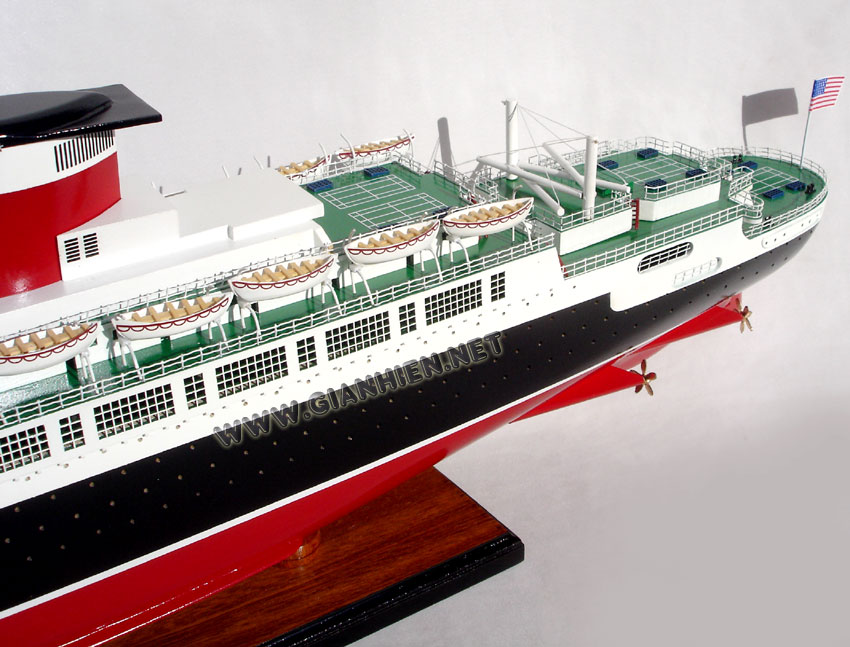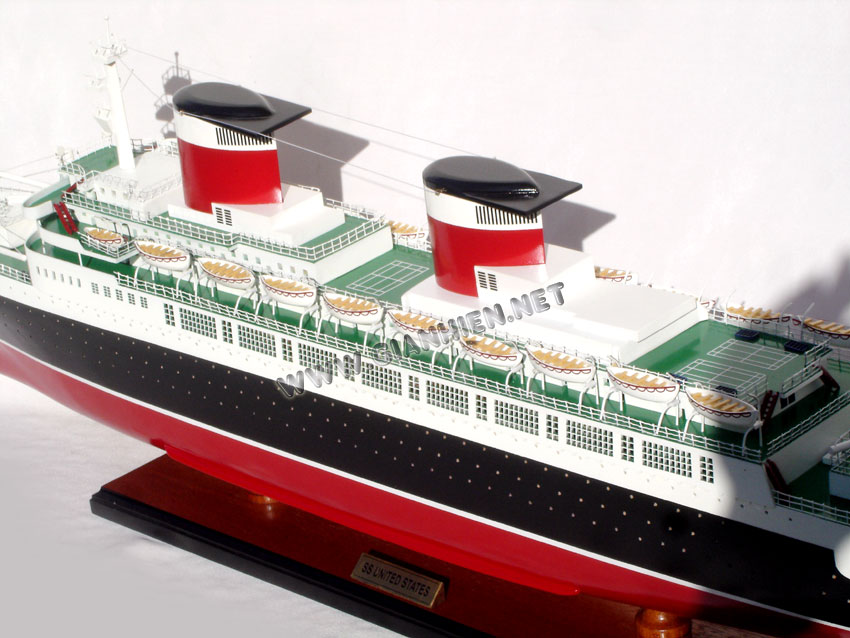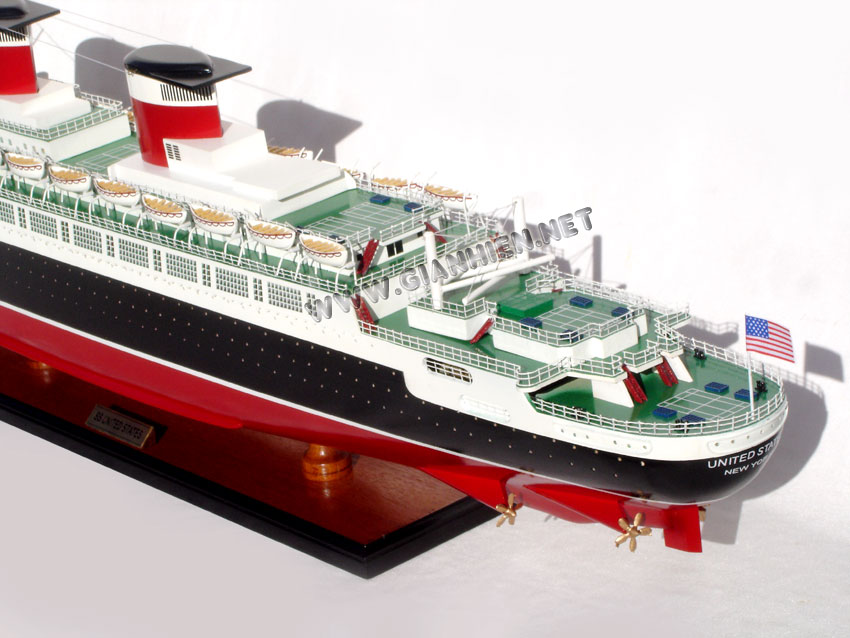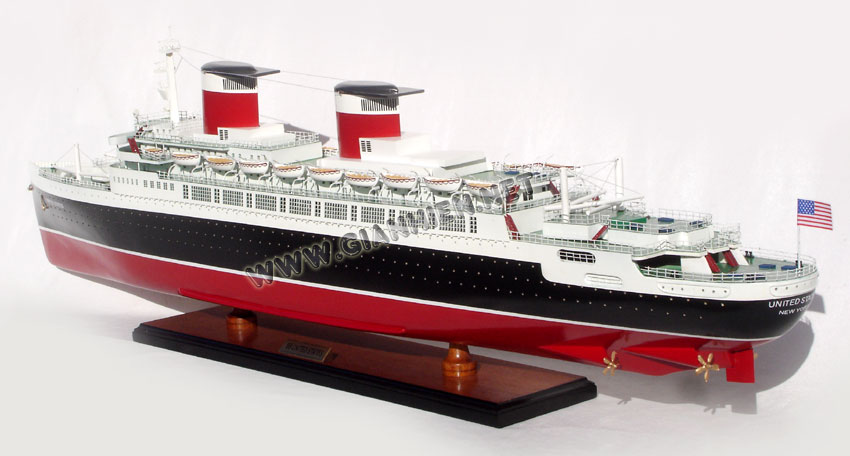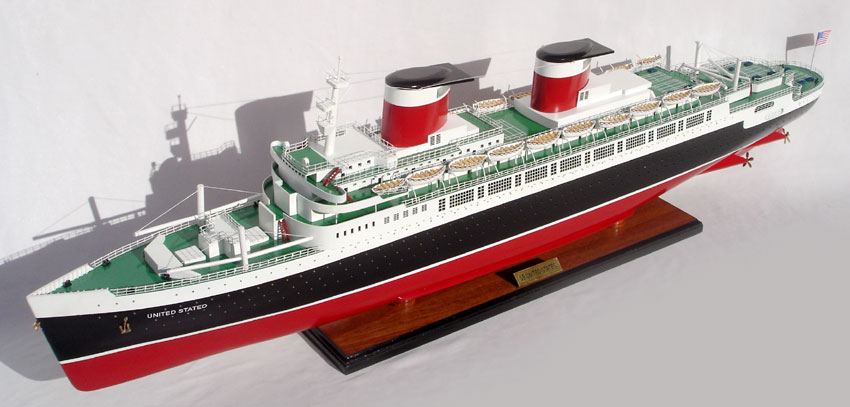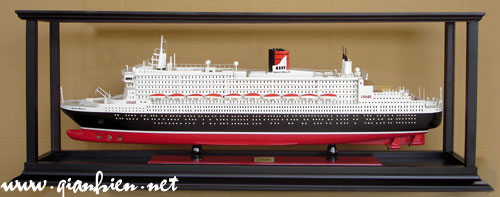|
HISTORY
In brief
SS United States is a luxury
passenger liner launched in 1952 for the United States Lines designed to
capture the trans-Atlantic speed record.
Built at a cost of $78 million, the ship is the largest ocean liner
constructed entirely in the United States, the fastest ocean liner to
cross the Atlantic in either direction, and retains in her retirement
the Blue Riband given to the passenger liner crossing the Atlantic
Ocean in regular service with the record highest speed.
Her construction partially subsidized by the United States government,
the ship was designed to allow conversion to a troop carrier should
the need have arisen. The United States operated uninterrupted in
transatlantic passenger service until 1969; since 1996 she has been
docked at Pier 82 on the Delaware River in Philadelphia.
Construction
Inspired by the exemplary service of the British liners RMS Queen Mary
and Queen Elizabeth, which transported hundreds of thousands of U.S.
troops to Europe during the Second World War, the federal government
of the United States decided to sponsor construction of a large and
very fast vessel that would be capable of transporting large numbers
of soldiers. Designed by renowned American naval architect and marine
engineer William Francis Gibbs, the liner's construction was a joint
effort between the United States Navy and United States Lines. The
U.S. government underwrote $50 million of the $78 million construction
cost, with the ship's operators, United States Lines, contributing the
remaining $28 million. In exchange, the ship was designed to be easily
converted in times of war to a troopship with a capacity of 15,000
troops, or a hospital ship.
The vessel was constructed from 1950-1952 at the Newport News
Shipbuilding and Drydock Company in Newport News, Virginia. The keel
was laid and the hull was constructed in a graving dock. United States
was built to exacting Navy specifications, which required the ship be
heavily compartmentalized and have separate engine rooms to optimize
war-time survival.
To minimize the risk of fire, the designers of United States used no
wood in the ship's framing, accessories, decorations or interior
surfaces. Fittings, including all furniture and fabrics, were custom
made in glass, metal and spun glass fiber to ensure compliance with
fireproofing guidelines set by the U.S. Navy. Though the galley did
feature butcher block, the clothes hangers in the luxury cabins were
aluminum. The ballroom's grand piano was of a rare, fire-resistant
wood species, though originally specified in aluminum — and accepted
only after a demonstration in which gasoline was poured upon the wood
and ignited, without the wood itself igniting.
The construction of the ship's superstructure involved the largest use
of aluminum in any construction project to that time, and presented a
challenge to the builders in joining the aluminum structure to the
steel decks below. The significant use of aluminum provided extreme
weight savings. At 105 feet (32 m) beam, United States was built to
Panamax capacity, ensuring the ship could clear the Panama Canal locks
with just 2 feet (0.6 m) to spare on either side.
United States had the most powerful steam turbine in a merchant marine
vessel. The ship was capable of steaming astern at over 20 kn (23 mph;
37 km/h), and could carry enough fuel and stores to steam non-stop for
over 10,000 nautical miles (12,000 mi; 19,000 km).
Captains of United States included Harry Manning, Roy Edward Fiddler,
John Anderson and Leroy J. Alexanderson.
Speed Records
On its maiden voyage on 4 July 1952, the United States broke the
transatlantic speed record held by the Queen Mary for the previous 14
years by over 10 hours, making the maiden crossing from the Ambrose
lightship at New York Harbor to Bishop Rock off Cornwall, UK in 3
days, 10 hours, 40 minutes at an average speed of 35.59 knots (40.96
mph) The liner also broke the westbound crossing record by returning
to America in 3 days 12 hours and 12 minutes at an average speed of
34.51 knots (39.71 mph), thereby obtaining both the eastbound and
westbound Blue Ribands — the first time a U.S. flagged ship had held
the speed record since the SS Baltic claimed the prize a century
earlier.
The United States maintained a 30-knot (35 mph) crossing speed on the
North Atlantic in a service career that lasted 17 years.
The United States lost the eastbound speed record in 1990 — however,
the United States continues to hold the Blue Riband as all subsequent
record breakers were neither in passenger service nor were their
voyages east and westbound.
The maximum speed of the United States was deliberately exaggerated,
and kept obscure for many years. An impossible value of 43 knots (49
mph) was leaked to reporters by engineers after the first speed trial.
The actual top speed — 38.3 knots (44.1 mph) — was not revealed until
1977. A Philadelphia Inquirer article reported the top speed achieved
as 36 knots (41 mph), while another source reports that the highest
possible sustained top speed was 35 knots (40 mph; 65 km/h)
Post-service
While United States was at Newport News for annual overhaul in 1969,
the shipping line decided to withdraw the ship from service, docking
the ship there. After a few years, the ship was relocated to Norfolk,
Virginia. Subsequently, ownership passed between several companies. In
1978, the vessel was sold to private interests who hoped to revitalize
the liner in a time share cruise ship format. Financing fell through
and the ship was placed up for auction by MARAD. During the 1980s,
United States was considered by the United States Navy as a troop ship
or a hospital ship, to be called the USS United States, but this plan
never materialized.
In 1984, the ship's remaining fittings and furniture were sold at
auction in Norfolk. Some of the furniture now represents a substantial
portion of the interior of Windmill Point, a restaurant in Nags Head,
North Carolina. These items include dining room tables and chairs in
the main restaurant and the bar and lounge tables and chairs in the
upstairs lounge as well as other items. One of the ship's propellers
is mounted at the entrance to the Intrepid Sea-Air-Space Museum in New
York City. Another propeller is mounted on a platform near the
waterfront at the United States Merchant Marine Academy in Kings
Point, NY. In 1992, a new consortium of owners purchased the vessel
and had the vessel towed to Turkey and then Ukraine, where it
underwent asbestos removal in 1994. No viable agreements were reached
in the U.S. for a reworking of the vessel, and in 1996 the United
States was towed to its current location at Pier 84 in South
Philadelphia. The ship is easily visible from shore and Interstate 95,
directly across Columbus Boulevard from the Philadelphia IKEA store.
While the United States lost the eastbound transatlantic speed record
in 1990 to Hoverspeed Great Britain, an Incat-built Norwegian-owned
wave-piercing catamaran ferry, it still holds the Blue Riband for the
westbound transatlantic speed record.
In 1999, the SS United States Foundation and the SS United States
Conservancy (then known as the SS United States Preservation Society,
Inc.) succeeded in having the ship placed on the National Register of
Historic Places.
Future plans
In 2003, Norwegian Cruise Line (NCL) purchased the ship from the
estate of Edward Cantor when the ship was put up for auction after his
death, with the stated intent of fully restoring the ship to a service
role in their newly-announced American-flagged Hawaiian passenger
service called NCL America. The SS United States is one of only a
handful of ships eligible to enter such service because of the Jones
Act, which requires that any vessel engaged in domestic commerce be
built and flagged in the USA and operated by a predominantly American
crew. In August, 2004, NCL commenced feasibility studies regarding a
new build-out of the vessel, and in May, 2006 Tan Sri Lim Kok Thay,
chairman of Malaysia-based Star Cruises (which owns NCL), stated that
the company's next project is "the restoration of the...United
States." By May, 2007, an extensive technical review had been
completed, with NCL stating that the ship was in sound condition. The
cruise line has over 100 boxes of the ship's blueprints cataloged.
While this documentation is not complete, NCL believes it will provide
useful information for the planned refit. However, when NCL America
began operation, it used the Pride of America, Pride of Aloha, and
Pride of Hawaii, rather than the United States, and later withdrew the
Pride of Aloha and Pride of Hawaii from Hawaiian service.
In February, 2009, it was reported that Star Cruises, to whom the
United States' ownership was transferred, and NCL are looking for
buyers for the United States.
A group of the ship's fans keeps in touch via the Internet and meets
annually in Philadelphia. The ship receives occasional press coverage,
such as a 2007 feature article in USA Today and there have been
various projects through the years to celebrate the ship, such as
lighting it on special occasions. A television documentary about the
ship entitled SS United States: Lady in Waiting was completed in early
February, 2008 and was distributed through Chicago's WTTW TV and
American Public Television with the first airings in May, 2008 on PBS
stations throughout the USA. The Big U: The Story of the SS United
States, another documentary about the ship, is currently in
development by Rock Creek Productions.
It was reported in March 2010 that scrapping bids for the ship are
being collected. Norwegian Cruise Lines, in a press release, noted
that there are large costs associated with keeping United States
afloat in her current state—around $800,000 a year—and that, as the SS
United States Conservancy has not been able to tender an offer for the
ship, the company was actively seeking a "suitable buyer
2009 - 2010 Rescue Efforts And Support
Ever since 2009 when Norwegian Cruise Line offered up the ship for
sale there have been numerous plans to rescue the liner from the scrap
yard.
The SS United States Conservancy, a group trying to save the ship from
the scrapyard has been trying to come up with funding to purchase the
ship.
On July 30, 2009, H. F. Lenfest, a Philadelphia media entrepreneur and
philanthropist, pledged a matching grant of $300,000 to help the
United States Conservancy purchase the vessel from Star Cruises.
A notable supporter, former US president Bill Clinton has also
endorsed rescue efforts to save the ship having sailed on the ship
himself in 1968.
As of May 7, 2010 over $50,000 has been raised by The SS United States
Conservancy
|


